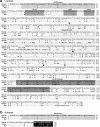Periaxin mutations cause recessive Dejerine-Sottas neuropathy
- PMID: 11133365
- PMCID: PMC1235266
- DOI: 10.1086/318208
Periaxin mutations cause recessive Dejerine-Sottas neuropathy
Erratum in
- Am J Hum Genet 2001 Feb;68(2):557
Abstract
The periaxin gene (PRX) encodes two PDZ-domain proteins, L- and S-periaxin, that are required for maintenance of peripheral nerve myelin. Prx(-/-) mice develop a severe demyelinating peripheral neuropathy, despite apparently normal initial formation of myelin sheaths. We hypothesized that mutations in PRX could cause human peripheral myelinopathies. In accordance with this, we identified three unrelated Dejerine-Sottas neuropathy patients with recessive PRX mutations-two with compound heterozygous nonsense and frameshift mutations, and one with a homozygous frameshift mutation. We mapped PRX to 19q13.13-13.2, a region recently associated with a severe autosomal recessive demyelinating neuropathy in a Lebanese family (Delague et al. 2000) and syntenic to the location of Prx on murine chromosome 7 (Gillespie et al. 1997).
Figures




References
Electronic-Database Information
-
- Chromosome 19 physical map, http://greengenes.llnl.gov//genome/html/chrom_map.html
-
- Electronic PCR, http://www.ncbi.nlm.nih.gov/genome/sts/epcr.cgi
-
- GenBank, http://www.ncbi.nlm.nih.gov/Genbank (for human PRX mRNA sequence encoding S-periaxin [AF321192] and human PRX mRNA sequence encoding L-periaxin [AF321191])
-
- HUGO Gene Nomenclature Committee, http://www.gene.ucl.ac.uk/nomenclature/ (for registered gene name PRX)
References
-
- Chomczynski P, Sacchi N (1987) Single-step method of RNA isolation by acid guanidinium thiocyanate-phenol-chloroform extraction. Anal Biochem 162:156–159 - PubMed
-
- Cohen RD, Campbell KP (2000) Molecular basis of muscular dystrophies. Muscle Nerve 23:1456–1471 - PubMed
-
- Dejerine J, Sottas J (1893) Sur la névrite interstitielle hypertrophique et progressive de l'enfance. Comp Rend Seanc Soc Biol 45:63–96
-
- Delague V, Bareil C, Tuffery S, Bouvagnet P, Chouery E, Koussa S, Maisonobe T, Loiselet J, Megarbane A, Claustres M (2000) Mapping of a new locus for autosomal recessive demyelinating Charcot-Marie-Tooth disease to 19q13.1-13.3 in a large consanguineous Lebanese family: exclusion of MAG as a candidate gene. Am J Hum Genet 67:236–243 - PMC - PubMed
-
- den Dunnen JT, Antonarakis SE (2000) Mutation nomenclature extensions and suggestions to describe complex mutations: a discussion. Hum Mutat 15:7–12 - PubMed
Publication types
MeSH terms
Substances
Associated data
- Actions
- Actions
- Actions
- Actions
- Actions
- Actions
Grants and funding
LinkOut - more resources
Full Text Sources
Other Literature Sources
Molecular Biology Databases

